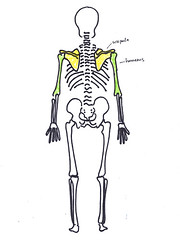Many a derby girl knows this, your arms are not... that well attached. Your ribs are connected to your spine in back and to your breastbone in front. That's all good, you have your skull to protect your brain, your spine to protect your spinal cord, and your rib cage to protect your heart and lungs. Your breastbone is connected to the medial or inside ends of your collarbones, the lateral or outside ends of your collarbones are attached to your shoulder blades, and your shoulder blades are attached to the proximal or near ends of your upper arm bones. Like, barely. Like your arms are basically dangling from your shoulder blades, and your shoulder blades are basically dangling from your collarbone. Think about that the next time you bash your shoulder into somebody else's.
What bones are at this joint?
So yeah, the bones at the shoulder girdle are the sternum or breastbone, the clavicle or collarbone, the scapula or shoulder blade, and the humerus or upper arm bone. But nevermind your arms for a minute, because the muscles at the shoulder girdle aren't so much about moving your arms as they are about stabilizing your shoulder blades. So that they don't wobble all over the place when you move your arms. I mean, right? Like walking on solid ground, and not having the ground wobble under your feet.
What type of joint is this?
This was asked on the practice test that I just scored 52% on, so I am adding it to my review. EVEN THOUGH IT WAS NOT REALLY COVERED IN THE CHAPTER. There are five joints in the shoulder girdle, and these are the types of joints they are:
- the sternoclavicular joint is a saddle synovial joint, which is a joint between concave and convex surfaces that works like a ball and socket
- the acromioclavicular joint is a plane synovial joint, which glides
- the glenohumeral joint is a ball and socket synovial joint
The other two joints in the shoulder girdle are fake joints:
- the scapulocostal joint attaches the shoulder blades to the ribs with soft tissue—i.e., the trapezius, rhomboid, and serratus anterior muscles
- the suprahumeral joint attaches the humerus to a scapular ligament
A joke!
Q: How many suprahumeral joints does it take to change a light bulb?
A: One.
Get it? Because the suprahumeral joint is what you use when you raise your arm high to change light bulbs.
What body part moves this joint?
When I say what body part, I sort of mean what meaty part and that will lead us to the muscles we're talking about. And when I say moves, I mean what meat is doing the heavy lifting. Which if I keep talking like that I'm going to end up vegan again. Here we're talking mostly about the back, but a little bit about the chest.
What body part is moved at this joint?
Here it's the back and a little bit of chest moving something that's in the back—that is, the shoulder blades. Which when they move may move the things they're connected to, but that's secondary to what we're talking about here.
Primary to what we're talking about here is, you can work your back muscles to stabilize your shoulder blades. The more stable your shoulder blades are, the more stable your shoulders are. The more stable and also the stronger your shoulders are, the less likely that your arm will fall off when you inevitably bash your shoulder into somebody else's.
Sold? More TK.

